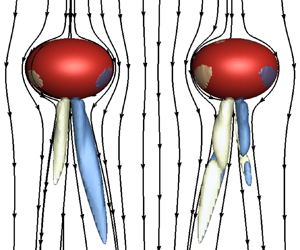Article contents
A numerical study of a bubble pair rising side by side in external magnetic fields
Published online by Cambridge University Press: 07 September 2021
Abstract

The motion of a pair of bubbles rising side by side under the influence of external magnetic fields is numerically examined. Through solving the fully three-dimensional Navier–Stokes equations, the results reveal that the bubble interactions are rather sensitive to the field direction and strength. At first, we identify that, in a hydrodynamic flow, whether the two bubbles will bounce or coalesce depends on the developments of the counter-rotating streamwise vortices during the collision. In particular, for an originally bouncing bubble pair, a streamwise magnetic field tends to promote their coalescence by weakening the strengths of the standing streamwise vortices, and such a weakening effect is caused by the asymmetric distribution of the Lorentz force in the presence of another bubble such that a torque is induced to offset the original streamwise vortices. Under a horizontal magnetic field, on the other hand, the influences are highly dependent on the angle between the bubble centroid line and the field: a transverse field or a moderate spanwise field always leads the bubble pair to coalescence while a strong spanwise field has the opposite effect. This anisotropic effect comes from the Lorentz force induced flow diffusion along the magnetic field, which not only produces two pairs of streamwise vortices at the bubble rear, but also homogenizes the pressure along the magnetic lines. As the competition between the two mechanisms varies with the magnetic direction and strength, the interaction between the bubble pair also changes. We show that the external magnetic fields control the bubble interaction through reconstructing the vortex structures, and hence the core mechanisms are identified.
- Type
- JFM Papers
- Information
- Copyright
- © The Author(s), 2021. Published by Cambridge University Press
References
REFERENCES
- 7
- Cited by



